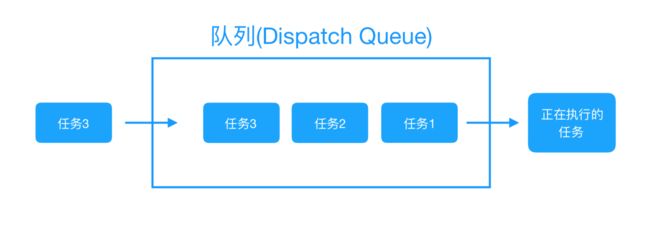iOS 多线程之任务和队列
iOS 多线程之任务和队列
前言
学习多线程,肯定要了解GCD,GCD两个最核心的概念就是:任务和队列。所以学习好多线程,首先要把任务和队列吃透,才能能好的使用多线程。
为什么使用GCD?
因为使用 GCD 有很多好处啊,具体如下:
- GCD 可用于多核的并行运算;
- GCD 会自动利用更多的 CPU 内核(比如双核、四核);
- GCD 会自动管理线程的生命周期(创建线程、调度任务、销毁线程);
- 程序员只需要告诉 GCD 想要执行什么任务,不需要编写任何线程管理代码。
任务
任务:就是执行操作的意思,换句话说就是你在线程中执行的那段代码。在 GCD 中是放在 block 中的。
执行任务有两种方式:
- 同步执行
- 同步添加任务到指定的队列中,在添加的任务执行结束之前,会一直等待,直到队列里面的任务完成之后再继续执行。
- 只能在当前线程中执行任务,不具备开启新线程的能力。
- 异步执行
- 异步添加任务到指定的队列中,它不会做任何等待,可以继续执行任务。
- 可以在新的线程中执行任务,具备开启新线程的能力。
两者的主要区别是:是否等待队列的任务执行结束,以及是否具备开启新线程的能力。
队列
这里的队列指执行任务的等待队列,即用来存放任务的队列。
-
队列是一种特殊的线性表
-
采用 FIFO(先进先出)的原则,即新任务总是被插入到队列的末尾,而读取任务的时候总是从队列的头部开始读取。
-
每读取一个任务,则从队列中释放一个任务。队列的结构可参考下图:
队列有两种:
-
串行队列(Serial Dispatch Queue)
- 每次只有一个任务被执行。让任务一个接着一个地执行。(只开启一个线程,一个任务执行完毕后,再执行下一个任务)
-
并行队列 (Concurrent Dispatch Queue)
- 可以让多个任务并发(同时)执行。(可以开启多个线程,并且同时执行任务)
注意:并发队列 的并发功能只有在异步(dispatch_async)方法下才有效。
GCD使用步骤
GCD 的使用步骤其实很简单只有两步:
- 首先创建一个队列(串行队列或并发队列);
- 最后将任务追加到任务的等待队列中,然后系统就会根据任务类型执行任务(同步执行或异步执行)
队列使用
可以使用 dispatch_queue_create 方法来创建队列。
- 第一个参数表示队列的唯一标识符,用于 DEBUG,可为空。队列的名称推荐使用应用程序 ID 这种逆序全程域名。
- 第二个参数用来识别是串行队列还是并发队列。DISPATCH_QUEUE_SERIAL 表示串行队列,DISPATCH_QUEUE_CONCURRENT 表示并发队列。
串行队列创建
-
创建串行队列
// 串行队列的创建方法 dispatch_queue_t queue = dispatch_queue_create("net.bujige.testQueue", DISPATCH_QUEUE_SERIAL); -
系统提供串行队列-主队列(Main Dispatch Queue)
// 主队列的获取方法 dispatch_queue_t queue = dispatch_get_main_queue(); -
所有放在主队列中的任务,都会放到主线程中执行。
-
系统提供dispatch_get_main_queue() 方法获得主队列。
注意:主队列其实并不特殊。 主队列的实质上就是一个普通的串行队列,只是因为默认情况下,当前代码是放在主队列中的,然后主队列中的代码,有都会放到主线程中去执行,所以才造成了主队列特殊的现象。
并行队列创建
-
创建并行队列
// 并发队列的创建方法 dispatch_queue_t queue = dispatch_queue_create("net.bujige.testQueue", DISPATCH_QUEUE_CONCURRENT);
-
系统提供的-全局并发队列(Global Dispatch Queue)
// 全局并发队列的获取方法 dispatch_queue_t queue = dispatch_get_global_queue(DISPATCH_QUEUE_PRIORITY_DEFAULT, 0); ``` -
可以使用 dispatch_get_global_queue 方法来获取全局并发队列。
-
需要传入两个参数。第一个参数表示队列优先级,一般用 DISPATCH_QUEUE_PRIORITY_DEFAULT。第二个参数暂时没用,用 0 即可。
创建任务方法
-
同步执行任务
// 同步执行任务创建方法 dispatch_sync(queue, ^{ // 这里放同步执行任务代码 }); -
异步执行任务
// 异步执行任务创建方法 dispatch_async(queue, ^{ // 这里放异步执行任务代码 });
任务和队列的组合
既然我们有两种队列(串行队列 / 并发队列),两种任务执行方式(同步执行 / 异步执行),那么我们就有了四种不同的组合方式。
这四种不同的组合方式是。
两种默认队列:全局并发队列、主队列:
-
全局并发队列可以作为普通并发队列来使用。
-
当前代码默认放在主队列中,所以主队列很有必要专门来研究一下,所以我们就又多了两种组合方式。
这样就有六种不同的组合方式了。
- 同步执行 + 串行队列
- 同步执行 + 并行队列
- 异步执行 + 串行队列
- 异步执行 + 并行队列
- 同步执行 + 主队列
- 异步执行 + 主队列
1.同步执行+串行队列
- (void)syncSerial {
NSLog(@"currentThread---%@",[NSThread currentThread]); // 打印当前线程
NSLog(@"syncSerial---begin");
//创建串行队列
dispatch_queue_t queue = dispatch_queue_create("testSerialQueue", DISPATCH_QUEUE_SERIAL);
dispatch_sync(queue, ^{
// 追加任务1
for (int i = 0; i < 2; ++i) {
// 模拟耗时操作
[NSThread sleepForTimeInterval:2];
// 打印当前线程
NSLog(@"1---%@",[NSThread currentThread]);
}
});
dispatch_sync(queue, ^{
// 追加任务2
for (int i = 0; i < 2; ++i) {
[NSThread sleepForTimeInterval:2];
NSLog(@"2---%@",[NSThread currentThread]);
}
});
dispatch_sync(queue, ^{
// 追加任务3
for (int i = 0; i < 2; ++i) {
[NSThread sleepForTimeInterval:2];
NSLog(@"3---%@",[NSThread currentThread]);
}
});
NSLog(@"syncSerial---end");
}
执行打印结果:
输出结果:
currentThread---{number = 1, name = main}
syncSerial---begin
1---{number = 1, name = main}
1---{number = 1, name = main}
2---{number = 1, name = main}
2---{number = 1, name = main}
3---{number = 1, name = main}
3---{number = 1, name = main}
syncSerial---end
同步+串行的特点:不会开启新线程,在当前线程执行任务。任务是串行的,执行完一个任务,再执行下一个任务。
2.同步执行+并行队列
- (void)syncConcurrent {
NSLog(@"currentThread---%@",[NSThread currentThread]); // 打印当前线程
NSLog(@"syncConcurrent---begin");
//创建并行队列
dispatch_queue_t queue = dispatch_queue_create("testConcurrentQueue", DISPATCH_QUEUE_CONCURRENT);
dispatch_sync(queue, ^{
// 追加任务1
for (int i = 0; i < 2; ++i) {
// 模拟耗时操作
[NSThread sleepForTimeInterval:2];
// 打印当前线程
NSLog(@"1---%@",[NSThread currentThread]);
}
});
dispatch_sync(queue, ^{
// 追加任务2
for (int i = 0; i < 2; ++i) {
[NSThread sleepForTimeInterval:2];
NSLog(@"2---%@",[NSThread currentThread]);
}
});
dispatch_sync(queue, ^{
// 追加任务3
for (int i = 0; i < 2; ++i) {
[NSThread sleepForTimeInterval:2];
NSLog(@"3---%@",[NSThread currentThread]);
}
});
NSLog(@"syncConcurrent---end");
}
打印结果:
currentThread---{number = 1, name = main}
syncConcurrent---begin
1---{number = 1, name = main}
1---{number = 1, name = main}
2---{number = 1, name = main}
2---{number = 1, name = main}
3---{number = 1, name = main}
3---{number = 1, name = main}
syncConcurrent---end
打印结果表明:
在当前线程中执行任务,不会开启新线程,执行完一个任务,再执行下一个任务。
执行完同步+串行、同步+并行结果表明:
- 同步情况串行和并行执行结果一样
- 同步不具有开启新线程的能力
- 并行队列虽然后并行执行任务的能力,但是在同步的情况下,没有开启新线程的能力,所以相当于串行执行(并行在同步的情况下,难免想起英雄无用武之地)。
3.异步执行+串行队列
- (void)asyncSerial {
//打印当前线程
NSLog(@"currentThread---%@",[NSThread currentThread]); 打印当前线程
NSLog(@"asyncSerial---begin");
dispatch_queue_t queue = dispatch_queue_create("testSerialQueue", DISPATCH_QUEUE_SERIAL);
dispatch_async(queue, ^{
// 追加任务1
for (int i = 0; i < 2; ++i) {
[NSThread sleepForTimeInterval:2];
NSLog(@"1---%@",[NSThread currentThread]);
}
});
dispatch_async(queue, ^{
// 追加任务2
for (int i = 0; i < 2; ++i) {
[NSThread sleepForTimeInterval:2];
NSLog(@"2---%@",[NSThread currentThread]);
}
});
dispatch_async(queue, ^{
// 追加任务3
for (int i = 0; i < 2; ++i) {
[NSThread sleepForTimeInterval:2];
NSLog(@"3---%@",[NSThread currentThread]);
}
});
NSLog(@"asyncSerial---end");
}
打印结果:
currentThread---{number = 1, name = main}
asyncSerial---begin
asyncSerial---end
1---{number = 3, name = (null)}
1---{number = 3, name = (null)}
2---{number = 3, name = (null)}
2---{number = 3, name = (null)}
3---{number = 3, name = (null)}
3---{number = 3, name = (null)}
直接结果表明:异步情况下会开启新线程,但是因为任务是串行的,执行完一个任务,再执行下一个任务。
4.异步执行+并行队列
- (void)asyncConcurrent {
// 打印当前线程
NSLog(@"currentThread---%@",[NSThread currentThread]);
NSLog(@"asyncConcurrent---begin");
dispatch_queue_t queue = dispatch_queue_create("net.bujige.testQueue", DISPATCH_QUEUE_CONCURRENT);
dispatch_async(queue, ^{
// 追加任务1
for (int i = 0; i < 2; ++i) {
[NSThread sleepForTimeInterval:2];
NSLog(@"1---%@",[NSThread currentThread]);
}
});
dispatch_async(queue, ^{
// 追加任务2
for (int i = 0; i < 2; ++i) {
[NSThread sleepForTimeInterval:2];
NSLog(@"2---%@",[NSThread currentThread]);
}
});
dispatch_async(queue, ^{
// 追加任务3
for (int i = 0; i < 2; ++i) {
[NSThread sleepForTimeInterval:2];
NSLog(@"3---%@",[NSThread currentThread]);
}
});
NSLog(@"asyncConcurrent---end");
}
执行打印结果:
currentThread---{number = 1, name = main}
asyncConcurrent---begin
2---{number = 5, name = (null)}
3---{number = 4, name = (null)}
1---{number = 3, name = (null)}
3---{number = 4, name = (null)}
1---{number = 3, name = (null)}
2---{number = 5, name = (null)}
执行结果表明:可以开启多个子线程,任务同时并行交替执行
在异步执行任务的情况,串行队列和并行队列表明:
- 异步情况下是开启新线程
- 异步下的串行也是是执行完一个任务,再执行下一个任务
- 异步下的并行开启多个子线程同时交替执行多个任务
4.同步执行+主队列
- (void)syncMain {
NSLog(@"currentThread---%@",[NSThread currentThread]); // 打印当前线程
NSLog(@"syncMain---begin");
dispatch_queue_t syncMain = dispatch_get_main_queue();
dispatch_sync(syncMain, ^{
// 追加任务1
for (int i = 0; i < 2; ++i) {
[NSThread sleepForTimeInterval:2];
NSLog(@"1---%@",[NSThread currentThread]);
}
});
dispatch_sync(syncMain, ^{
// 追加任务2
for (int i = 0; i < 2; ++i) {
[NSThread sleepForTimeInterval:2];
NSLog(@"2---%@",[NSThread currentThread]);
}
});
dispatch_sync(syncMain, ^{
// 追加任务3
for (int i = 0; i < 2; ++i) {
[NSThread sleepForTimeInterval:2];
NSLog(@"3---%@",[NSThread currentThread]);
}
});
NSLog(@"syncMain---end");
}
执行结果:
currentThread---{number = 1, name = main}
syncMain---begin
直接结果表明:互等卡主不执行,产生死锁崩溃。
默认主线程在等待syncMain执行完任务1再往下执行,syncMain在等待默认主线程执行完再执行syncMain中任务1,所以互相等待产生死锁。
6.异步执行+主队列
- (void)asyncMain {
// 打印当前线程
NSLog(@"currentThread---%@",[NSThread currentThread]);
NSLog(@"asyncMain---begin");
dispatch_queue_t queue = dispatch_get_main_queue();
dispatch_async(queue, ^{
// 追加任务1
for (int i = 0; i < 2; ++i) {
[NSThread sleepForTimeInterval:2];
NSLog(@"1---%@",[NSThread currentThread]);
}
});
dispatch_async(queue, ^{
// 追加任务2
for (int i = 0; i < 2; ++i) {
[NSThread sleepForTimeInterval:2];
NSLog(@"2---%@",[NSThread currentThread]);
}
});
dispatch_async(queue, ^{
// 追加任务3
for (int i = 0; i < 2; ++i) {
[NSThread sleepForTimeInterval:2];
NSLog(@"3---%@",[NSThread currentThread]);
}
});
NSLog(@"asyncMain---end");
}
执行打印结果:
currentThread---{number = 1, name = main}
asyncMain---begin
asyncMain---end
1---{number = 1, name = main}
1---{number = 1, name = main}
2---{number = 1, name = main}
2---{number = 1, name = main}
3---{number = 1, name = main}
3---{number = 1, name = main}
因为主线程是串行队列,所以在主线程中执行任务,执行完一个任务,再执行下一个任务。
总结
-
串行队列的特点:
- 无论同步任务或是异步任务,任务按顺序执行,一个执行完毕执行下一个任务
- 串行队列 执行同步任务不开辟线程
- 执行异步任务开辟最多开辟一条线程并且按顺序执行
-
并行队列的特点:
- 执行异步任务具备开辟多条线程的能力
- 执行同步任务,顺序执行,因为同步不具有开辟线程的能力
-
同步任务特点:
- 没有开启新线程的能力
- 在当前线程任务按顺序一个一个执行
-
异步任务的特点:
- 具有开启新线程的能力
- 开几条新线程取决于队列,串行队列开启一条线程,并行队列在执行多个异步任务时会开辟多条线程。

